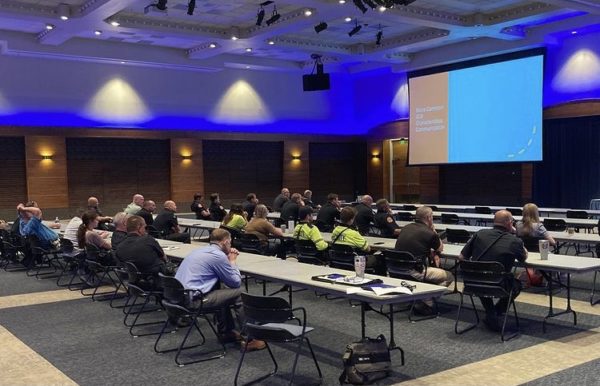Police training for autism interactions held at USU
On Aug. 4, Utah State University held a training for police officers and other first responders about interactions with individuals on the autism spectrum.
The training was required for all USU Police Department officers.
The training included what autism spectrum disorders are, how to communicate and respond effectively to those individuals, and how to recognize the related symptoms.
This comes after a new law passed this year that requires all Utah peace officers to have autism specific training each year.
Although this is the first time this specific training has happened at the university, the lead for this training, Dr. Michelle Lizotte, plans to offer it annually.
Lizotte is a professor at USU who has experience working with individuals on the autism spectrum. She hopes there can be various levels in the future that will incorporate more advanced materials and interaction strategies.
In-person attendance consisted of 15 USU police officers, 15 Logan City Fire Department paramedics, 22 Logan City Police Department officers, and a few officers from the Cache County Sheriff’s Office, Smithfield City Police Department and North Park Police Department.
Online attendees included officers from other schools such as Brigham Young University, Weber State University, Dixie State University, Utah Valley University and Salt Lake Community College.
Lizotte said it was important that officers from all over Utah were there. She also said this training has become necessary to protect both police officers and individuals with ASD.

She explained that many of the officers who had attended the training didn’t know some of the ASD signs to look for, which can be dangerous considering that the behaviors can have similarities to someone on drugs.
“For example, eye contact,” Lizotte said. “People on the spectrum typically have difficulty making eye contact while interacting with someone. If a police officer did not know this, they may think the individual is being deceitful or hiding something.”
This same thing is what worries parents with autism children. During a research study from ASAN, or Autistic Self Advocacy Network, on autism safety, one parent advocate talked about their concerns with their son, “Him being non-compliant will make them think he is resisting and they may kill or hurt him. He may become combative because of sensory overload or fear and they will hurt him.”
Captain Kent Harris of the USU Police Department understands this issue and is very grateful there are experts on campus who can help law enforcement gain a better understanding.
“When a parent calls law enforcement to come and deal with their child who is on the spectrum, they have exhausted their resources,” Harris said, “A few hours of training doesn’t make us experts — far from it — but it gives us an idea of what we are being called to do.”
Other symptoms of ASD could also be non-verbal responses, stimming (clapping, spinning, etc.) or long delays in answering questions.
Suggestions from the training to help officers in those scenarios included approaching the individual slowly, turning off lights and sirens, using a calm voice and avoiding any physical contact if possible.
According to a survey study done by the Autism Society, 35% of autistic individuals had been the victim of a crime and 23% have had interactions with first responders due to wandering or eloping.
In these cases, the best results came when the first responders had an understanding of what to expect and how to provide the appropriate response.
This is exactly why Lizotte believes multiple training sessions on ASD interactions are absolutely necessary for all officers.
Lizotte also noted the current rate of ASD in the U.S. is 1 in 54, which means that there is an increased likelihood of not only an officer having to interact with an autistic individual but any citizen.
USU police Chief Earl Morris said, “I believe that we in society do not understand autism and how it affects so many individuals and their families. Greater understanding and compassion can help not only those without autism but imaging how it will improve the lives of those who do.”
Morris and Harris both agreed the training was not only necessary but also extremely beneficial and effective.
Cordell Hancock, a junior at USU, also believes ASD discussions for police are very valuable, however, he also thinks it could be beneficial for people outside of law enforcement.
“I think opening up autism interactions training for others would be useful, but enforcing it would be useless,” he said, “For those that are interested, the option should absolutely be made available.”
Lizotte called law enforcement interaction with autism a “nationwide problem.” She explained that there are dozens of videos and stories of police interactions with individuals on the spectrum going horribly wrong. However, discussions like this are without a doubt a step towards solving the issue.
“There is no way to cover everything necessary for communication with autistic people in only 2 hours,” Lizotte said, “but hopefully this training helps officers identify potentially autistic persons and use the strategies in their interactions.”
Jacee.Caldwell@usu.edu
@JaceeCaldwell

